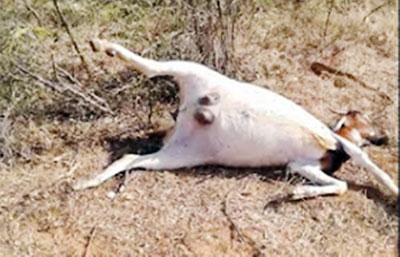
Making a killing with poisoned food
The ongoing drought conditions affecting many parts of the country is taking a deadly toll of animals and inland fish.
Wildlife officials from drought-stricken areas reported hunters had taken to poisoning natural waterholes where animals and birds regularly quench their thirst at Suriyawewa, Weliwewa and in 14 tanks found in Hambantota. This has already led to the death of a deer and seven goats in the vicinity of the waterholes.Unfortunately actions of unscrupulous persons attempting to make a fast buck via this sad situation are posing much danger to both man and beast.
What is worse is the flesh is being sold to villagers, despite the health risks involved.
Last week at the Kalawewa tank in Anuradhapura a haul of dead fish was discovered. The reason behind their death still remains a mystery and a foul odour prevailed in the area as a result of the putrefying fish.
However villagers are reportedly collecting the dead fish floating on the surface, for consumption. The product is also sold in the open market, despite the health risks.
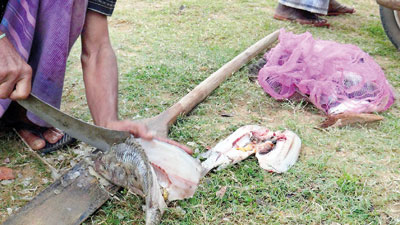
An unscrupulous man cuts up a dead fish which will soon be put on sale

Unscrupulous traders may land this large dead fish which was washed ashore in your cooking pot or mine
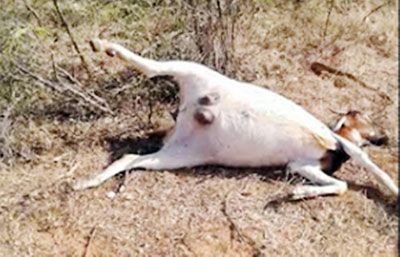
Beware, hunters have taken to poisoning animals whose flesh they later sell to unsuspecting buyers

A crow attacking a tasty morsel
Source – 20/08/2017, The Sunday times, See more at – http://www.sundaytimes.lk/170820/news/making-a-killing-with-poisoned-food-255438.html

Fishing boats in the regulatory net for plastic waste
Thousands of fishing vessels that carry plastic water bottles and containers will be required to bring them back to shore under new laws being pondered to cut down the plastic waste piles that litter the oceans around Sri Lanka and choke precious marine life.

Sri Lanka among top marine polluters
When fishing vessels return to port, crews will be required to account for plastic containers they took on board. There are an estimated 53,900 fishing vessels in the dozen main fishing districts. The industry will be encouraged to use larger — five litres or more — water containers.
The Ministry of Fisheries and Aquatic Resources has joined hands with Marine Environment Protection Authority to bring in these measures.
Director General Christie Fernando said that all fishing vessels will have to account for the number of bottles of water. Boats will only be allowed to have on board containers of five-litre capacity or more and each vessel will be asked to report the number of bottles they have and account for the same on their return.
Fernando said that about 4,000 multi-day vessels cary about 100,00 litres of water to last a month. “They use the water for washing, cleaning, cooking purposes.’’
Fernando said a circular has been sent to all the district fisheries offices and to assistant fisheries directors. The regulation is being drafted and will be incorporated in the act soon, he said.
The Marine Environment Protection Authority said 22 fishing harbours will be monitored together with the Fisheries Ministry.
Chairman Rohana Perera said awareness of plastic waste will be raised. “We are encouraging them to manage, minimise and re-use plastic responsibly.’’
Source – 20/08/2017, The Sunday Times, See more at – http://www.sundaytimes.lk/170820/news/fishing-boats-in-the-regulatory-net-for-plastic-waste-255471.html

Desperate national parks battle poachers, curtail safaris and campers
National wildlife parks are struggling with an increase in poaching and are limiting access to safari operators and campers amid a devastating drought.
 A fishing cat (handun diviya) was rescued last morning when the desperate animal in search of water had fallen into a well in Digampathana, Dambulla . Pic by K. Kanchana Kumara Ariyadasa
A fishing cat (handun diviya) was rescued last morning when the desperate animal in search of water had fallen into a well in Digampathana, Dambulla . Pic by K. Kanchana Kumara AriyadasaThe Yala National Park may even be closed to visitors next month.
There have been reports of animals poisoned at watering holes by poachers at various national parks.
Despite the drought, wildlife officials also say they will provide water only if necessary and instead allow nature to take its course.
Safari jeep operators are complaining of restrictions imposed on them.
The director general of the Department of wildlife Conservation, M G C Sooriyabandara said, park wardens are given the discretion to manage the situation and reduce safari vehicles entering the parks. “Even a one way system has been devised to reduce the same vehicles running up and down,” he said.
He said that the Yala National Park will be closed in September.
Mr Sooriybandara said that officials will rarely intervene in nature and will provide water only if it necessary.
“When we provide water, we choose tanks and watering holes near the safari trails regularly visited by tourists to attract animals, and to make sure that the regularly monitored area is secure from poachers.’’
He said joint patrols are undertaken against wildlife poachers. Wildlife range offices near national parks provide two officials from each office to combine with park rangers and form teams of 10 to carry out raids.
Meanwhile, park rangers and wardens have prepared their own plans.
The warden of the Wilpattu National Park, Chamath Lakshman Perera, said only 30 safari jeeps are allowed at a time, between 6:00 am and 10:00 and then from 2 p.m. to 6 p.m.Mr Perera added that both bungalows and campsites have been closed.
He said 28 small water tanks are being filled up using tanker trucks.
“Lots of poaching activities are happening during the dry months, so we reduce the safari jeeps,’’ he said.
Recently, they detected 13 trap guns and captured four armed men.
A wildlife official said the Yala National Park will be closed next month and will be re-opened after October.
Buddika Widanage, warden at Gal Oya National Park, said it was not badly affected by the drought thanks to the Senanayaka Samudraya. But he said the water levels in the reservoir had dropped.
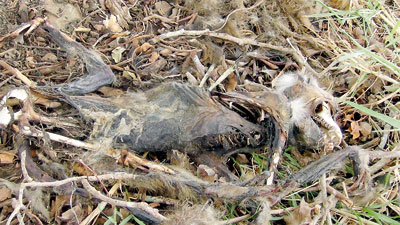
Thabbowa sanctuary: Fast turning into a graveyard for wild animals. Pic by Hiran Priyankara
He said park rangers and officials of the nearby wildlife offices carry out night patrols to catch poachers who set up trap guns or leave poisoned food at watering holes.
Mr Widanage also said campers are only allowed if they bring their own water.
“Even the three-hour boat rides have been cut to two hours” he said.
The Minneriya Park has suffered from the drought since last year, warden Bhathiya Madugalle said. Elephants are the worst effected — less than 10 remain in the park. Animals have moved to Kandalama Park and Ritigala Eco Park.
Mr Mudalige said that there is also less elephant grass.
He explained that water and food are not provided to animals so that the natural balance is maintained and to allow for the survival of the fittest.
Meanwhile, the Independent Safari Jeep Drivers Association claims unfair treatment.
The head of the group, P D Keerthi, said most parks had reduced access. He claimed the operators could provide water and food for anim,als but wildlife officials and the minister would not allow it.
Mr Keerthi also said the one way drive system for safari jeeps could be dangerous in the event of an attack by elephants, when reversing is the only choice.
He complained that although they are regulated, VIPs are allowed roam in the parks day and night.

Source – 20/08/2017, The Sunday Times See more at – http://www.sundaytimes.lk/170820/news/desperate-national-parks-battle-poachers-curtail-safaris-and-campers-255478.html

The ‘Glen Falls’ at Nuwara Eliya is no more
The ‘Glen Falls’ which added much scenic beauty to Nuwara Eliya is drying up. The waterfall once synonymous with the town of Nu wara Eliya of which many a hotel and roads are named after is now visible only on rainy days. Area residents have watched as the waterfall dried up before their eyes.
wara Eliya of which many a hotel and roads are named after is now visible only on rainy days. Area residents have watched as the waterfall dried up before their eyes.
Colonial Governor Edward Barnes who designed and developed the town of Nuwara Eliya, set up his official residence in the vicinity of the magnificent 60 -70 metre high falls.
Today this beautiful waterfall is no more.
Despite the waterfall reappearing mainly during the monsoon season, this unfolding disaster does not seem to have attracted the attention of either the populace or those in positions of trust and authority.
Environmentalists claim the over utilisation of this precious water resource for the fast expanding commercial purposes as well as public sanitation, paved the way for the drying up of this once beautiful landmark.
They add potato cultivation on hill tops which commenced in the sixties also contributed to the drying up of the falls whose source spring is situated close to Shanthipura Kala Oya on the ‘Single Tree Mountain Range’ around 6,830 ft above sea level.
The then town of Nuwara Eliya 12.43 sq km in extent, was carved out by the British in 1828 and was originally a town of farmers with one Samuel Baker opening a 1,000-acre farm in 1848.
According to the census of 1881 ordered by then Government Agent (GA) Baros, the town was home to a population of 1,701 persons comprising 270 families.
Today the population consists of 35,000 persons, comprises around 7,500 houses, 3530 commercial buildings and 803 government buildings.
During the dry season water to the city is severely restricted as the sources for drinking water and sanitation needs remain the same as in 1881, other than the few deep-water wells provided via Japan’s JAICA.
The spurt in hotel construction will further stretch the scarce water resources in the area and will undoubtedly aggravate the situation.
If the situation is not tackled with sensitivity even the future existence of the city of Nuwara Eliya remains at risk.

Source – 20/08/2017,The Sunday Times, See more at – http://www.sundaytimes.lk/170820/news/the-glen-falls-at-nuwara-eliya-is-no-more-255450.html

See the agony of this monkey, but what do we do?
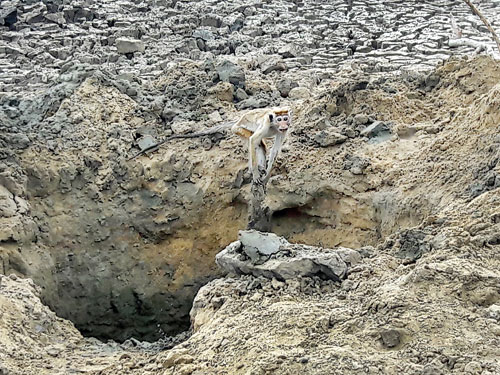
A skeletal monkey with little but skin and bone is seen after it quenched its thirst and struggled out of a temporary well that compassionate people had dug with a cloth ladder for the voiceless and helpless creatures in the fire and fury of the ongoing drought. The temporary well was dug at the Meegaswewa tank in the Thabbowa Park in the Puttalam District. Reports say hundreds of monkeys and other animals have died after suffering for weeks and months in the barren waste. Pic by Karuwalagaswewa Jayaratne.
Source – 20/08/2017, The Sunday Times, See more at – http://www.sundaytimes.lk/170820/news/see-the-agony-of-this-monkey-but-what-do-we-do-255590.html

Death of seven-feet leopard being probed
The Wild Life Conservation Department is probing the death of a seven-feet male leopard in the Deltota, Lulakanda area.
Assistant Forest Range officer G R Dharmarathna told the Daily Mirror that the leopard was found dead on Monday evening following information provided by resident to the area wild life office.
An official from the Wild Life Conservation Department said the carcass of the leopard was handed over to the Peradeniya veterinary surgeon for a postmortem.
He said the reason for the leopard’s death had not been established so far.
The Sri Lankan leopard is a subspecies of leopards native to Sri Lanka that was first described in 1956 by the Sri Lankan zoologist Deraniyagala.
The leopard was listed as an Endangered species on the International Union for Conservation of Nature (IUCN) Red List in 2008 is also an offense to kill, trade or harm a leopard under the Wildlife Act.


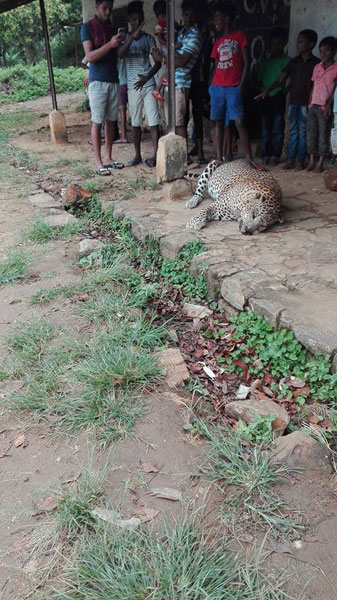
Source – DailyMirror, See more at – http://www.dailymirror.lk/134995/Death-of-seven-feet-leopard-being-probed

Unexpected beauty of SRI LANKA’S MANGROVES

Tourism in Sri Lanka – the tropical island nation just a stone’s throw from the tip of southern India – is on an upswing, thanks to thousands of miles of sugar-sand coastline, lush interiors dotted with tea plantations and the mystique of a place that’s still relatively undiscovered.
And while the country’s pristine beaches, not yet overrun with tourists or towering condos, draw budget and luxury travellers alike from around the world, a different kind of coastal tableau – shallow, shore-hugging waters where mangrove forests grow – is not only worth exploring, but a matter of national attention.
In Negombo, a laid-back beach town roughly 20 miles north of the country’s capital, Colombo, tours of the area’s wetlands start across the street from the Muthurajawela Visitor Centre, in the gray-green waters of the Dutch Canal.
This long, narrow waterway was built in the 18th century to transport spices and now links Negombo and Colombo. As the sun sinks towards the horizon, I climb aboard a modest, motorized boat for a 90-minute tour led by Amal Priyankara, a 26-year-old naturalist and Negombo native.
As our boat slowly plies the canal, Priyankara points out birds that, to an untrained eye, are slow to appear among the leaves, branches and brush.
In the 30 or so minutes, it takes us to reach the end of the waterway, we spot white-throated kingfishers, cormorants, graceful green and purple herons, cattle egrets, red lapwings and other colorful birds.
Eventually, our boat arrives at the canal’s northern mouth and moves into the wide-open Negombo Lagoon, a shallow, 3,000-hectare expanse of saline water surrounded by dense, green, leafy growth.
We cruise at a comfortable clip for several minutes, passing the occasional fisherman and school of silver flying fish. With the sky growing pink and gold above us, Priyankara motions to our captain, who sidles the boat up snugly along a thicket of shrubs, their long, narrow roots reaching down into the water like skinny, splayed fingers. Long, green pods with pointed ends dangle from several of the plants’ branches, like javelins waiting to pierce the placid surface.
“Rhizophora mangroves,” says Priyankara, giving a name to the tangle. Sri Lanka is home to 29 species of mangroves. He’s seen 16.
Importance of mangroves
“Mangroves are a really big topic in my country,” he says. “Schools are teaching kids about them.”
Education is key as mangroves play a crucial role in Sri Lanka’s – and the world’s – coastal ecosystem that extends far beyond the aesthetics they bring to a boat tour. They provide critical shelter for young fish (replenishing coral reefs and fisheries, thus facilitating the livelihood of Sri Lankans who fish for a living) and sequester up to 50 times more carbon dioxide than other kinds of forests, making them indispensable in combating climate change.
They also act as a buffer against tropical storms, reducing damage to coastal communities. (Some studies have shown that areas with more substantial mangrove forests fared better during the 2004 tsunami than did communities without them.) But for all their virtues, mangroves are also at risk, having been dangerously depleted in recent decades thanks in large part to the country’s shrimp-farming industry.
“Sri Lanka generally lacks rules and education about the environment,” says Priyankara.
Women leading the way
That’s all changing now, though, thanks to Berkeley, California-based Seacology, which is about halfway through a five-year partnership with Sri Lankan NGO Sudeesa (formerlyknown as the Small Fisher Federation of Lanka) to teach Sri Lankans about the importance of mangroves.
The organizations provide small-business tools and micro loans to 15,000 local women in exchange for their commitment to help conserve, rehabilitate and replant all of the nearly 22,000 acres of mangrove forests that grow along the country’s coasts.
Anuradha Wickramasinghe, chairman of Sudeesa, says that the organizations targets women in particular because “much of the information and direction in households here is funneled down through them.”
Through the organizations’ Sri Lanka Mangrove Conservation Project, women in 14 districts and 1,500 small communities located near mangrove forests complete mandatory three-day training on mangrove conservation, business management and livelihood development before receiving micro loans that allow them to start or expand their own small businesses.
These range from roadside snack bars and grocery markets to drying and selling fish for household cooking to handcrafting rope ties for fishing boats, to name just a few. In 2016, the organizations opened the Seacology-Sudeesa Mangrove Museum on the grounds of Sudeesa’s headquarters in Chilaw – roughly an hour’s drive north of Negombo on Sri Lanka’s west coast – as a place to educate locals, students and ecologically minded tourists about all things mangroves.
Visitors enter the new museum through a spacious theater where a film offers insight into the ecology, plight and conservation of Sri Lanka’s mangroves.
Inside the sunlit exhibit hall, visitors find dozens of species of mangrove-dwelling creatures – carefully preserved and neatly displayed in jars and on shelves – plus diagrams and illustrations depicting everything from different types of mangroves to the plants’ eco-mechanics.
On nearby Colombo Road, dozens of the program’s micro-loan recipients gather daily in a small, open-air marketplace to sell their wares – fresh fruit and vegetables, packaged local spices, terracotta garden pots, colorful clothes, and handicrafts, among other goods. “We feel very proud,” several of the women say of their business achievements.
Support from Sri Lanka’s Navy
Seacology’s and Sudeesa’s reach within Sri Lanka is extensive. The organizations also run a Northern Regional Centre in Mannar, in the country’s quiet, war-ravaged north, where many of the women who cycle through the program are conflict widows. As in Chilaw, the Mannar facility is home to a mangrove nursery (there are three nurseries in total throughout the groups’ facilities), where seedlings are nurtured and prepped for replanting in wild coastal habitats.
And farther north still, near Jaffna, Seacology and Sudeesa are working with Sri Lanka’s Navy to replant mangroves and to spread the word about conservation throughout the surrounding communities.
Together, the Navy, Seacology, and Sudeesa have planted about 38,000 mangroves around Sri Lanka. For the officers who were enlisted then, this life – marked by conservation and community outreach – is a far cry from the tense civil war that raged here less than a decade ago.
Back on Negombo Lagoon, the sky starts to darken, and it’s time for our tour to end. As we motor away from the mangroves, I take a last look over the side of the boat, marveling at all of the life that the mangroves sustain – both under water and on land. Making our way back toward the Dutch Canal, Priyankara explains that the mangrove ferns that make up the foundation of several small islands within the lagoon were, for a time, on the country’s ‘RedList’, an ominous marker of conservation status for Sri Lankan flora and fauna.
But thanks to protective measures put into place in recent years, they’re now on the rebound and off that list. Surrounded by the lush beauty of Negombo Lagoon, one can’t help but hope that, as tourism continues to flourish in this tiny island country, so, too, do its precious mangroves.
CNN





Source – Nation, see m,ore at – http://nation.lk/online/2017/08/12/unexpected-beauty-of-sri-lankas-mangroves.html

Wildlife officers rescue ‘Fishing Cat’ from well

Wildlife officers from the Department of Wildlife Conservation’s (DWC) Sigirya office have managed to successfully rescue a large Fishing Cat (Handun Diviya) which had fallen into a well at Digampathana in Dambulla.
The incident took place yesterday (17). Villagers had seen the Fishing Cat fallen inside the well unable to get out. They had at first tried to rescue the animal themselves, but given the danger involved to the animal and themselves, had alerted wildlife officers.
DWC officers had arrived within minutes and had managed to successfully pull the animal out of the well using a noose made of wire. The Fishing Cat had then freed itself from the noose and fled into the jungle.
Source – 18/08/2017, TimesOnline, see more at – http://www.sundaytimes.lk/article/1029810/wildlife-officers-rescue-fishing-cat-from-well

Indira Gandhi Zoological Park initiates steps to bring 10 different species including Pygmy Hippo from Colombo

The Indira Gandhi Zoological Park has initiated steps to bring 10 different species of wild animals and birds from Israel, Colombo, Germany, Czech Republic and Japan zoos this year, the Deccan CHronicle reported.
Zoo curator B. Vijaya Kumar was quoted as saying plans were underway to bring a Pygmy Hippopotamus from Colombo. Further, he said other animals would be Chapman Zebra, Oliver Baboon from Israel, Fishing cat, Red Necked Wallabies, Scarlet Macaw, Military Macaw from the Czech Republic and Greater Flamingos from Japan would be brought to the zoo park in this fiscal only.
Under the International Animal Exchange Programmes, zoos can bring inmates from other places after obtaining permission from Central Zoo Authority. “Impressed with the vast natural habitat of the zoo, the Israel Nature and Parks Authority (INPA) had shown interest to give four zebras,” he said.
Source – 16/08/2017,TimesOnline, See more at – http://www.sundaytimes.lk/article/1029638/indira-gandhi-zoological-park-initiates-steps-to-bring-10-different-species-including-pygmy-hippo-from-colombo
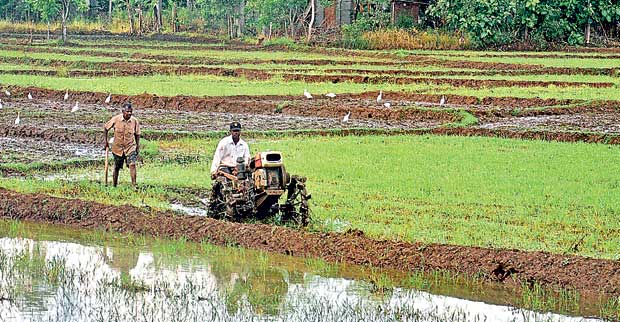
Sri Lanka, it’s high time for a Green Revolution
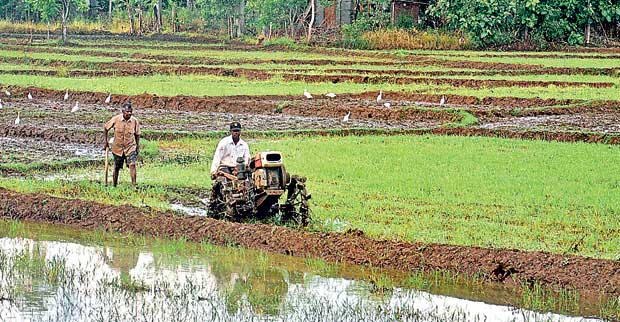
Sri Lanka, once identified at a time known granary of the East, is now almost reliant on imported food items. The unfolding problematic situation arose due to the considerable decline in domestic food production. As the global food crisis deepens due to various reasons, including armed conflicts, macro-economic collapses and natural disasters like droughts, many countries have started focusing on domestic food production. Sri Lanka’s agriculture-still being considered the most important yet- is a less encouraged sector that needs to undergo a transformation. Senior Social Scientist and Former Head of Sociology Department of the Colombo University Prof. Siri Hettige described this transformation as a ‘Green Revolution’. During an interview with the Daily Mirror, Prof. Hettige outlined the importance of taking the necessary actions to improve the productivity of the domestic agriculture sector. He said that this should be backed by investment on research, new scientific methods of farming and appropriate policy changes with the ultimate goal being known as the granary of the East again. Further, he aired his views on the significance of replacing non-bio degradable materials with bio-degradable materials which he said will solve the long-standing waste management issue and create a healthy environment.
How serious issues were dealt with
In the 1960s, the green revolution was a major policy response of many developing countries like Mexico, India, Pakistan, the Philippines and Sri Lanka. This was their response to a number of serious issues in traditional agriculture including low productivity, vulnerability of farmers, poverty and malnutrition. Consequently, agricultural scientists and others were exploring various ways to improve the small scale agriculture sector and the quality of lives of rural farmers. The change was made by introducing a range of new agricultural technologies.
Following decolonization, the population increased in many ex-colonial countries where there was stagnation of traditional agriculture. These countries faced a need to improve the conditions in rural areas since people were moving away from these areas, making the cities unmanageable. The Governments of such developing countries advocated certain interventions which were quite different to techniques used in large-scale industrial agriculture in countries like the United States. The new package that was introduced by the Governments included new seed varieties, new agricultural techniques like planting and mechanical type technologies. All these new methods gradually improved productivity of the lands. Consequently, the people had a much bigger yield whilst poor living conditions of farmers and issues caused by scarcity were addressed. The green revolution was backed by research conducted by newly established research stations.
Adopting a new green revolution in Sri Lanka
Sri Lanka and other countries need a new type of green revolution in response to a much bigger challenge we face at present; unsustainable development and unsustainable consumption. Development is taking place almost everywhere, but not in a sustainable manner. Correspondingly, there is unsustainable consumption. Both have resulted in major issues that are prevailing in the world such as climate change and the increasing disaster situations.
Slow onset disasters like floods and droughts appear to be sudden events. Nevertheless, they are part of a long- term trend. Accumulation of toxic waste is another problem. Some industrial products contain harmful substances. Such toxic materials end up in our food chain, water ways and even in the ocean. Some of the materials, that we have got used to, pose huge challenges in terms of disposal, pollution of the water ways, soil structure and the environment.
The main reason for this situation is the expansion of the industrial civilization, beyond the boundaries of traditional industrialized countries. The expansion of the industrial civilization has affected production and consumption of goods and services at an unprecedented rate.
-
Scientists should come up with bio degradable materials which are as good as plastics.
-
We have an artificially created labour problem.
-
Well-to-do people should use surplus of their income to create employment.
-
In India, green revolution made a huge impact.
Improving rural agriculture
Owing to the fact that Sri Lanka has been moving away from rural agriculture, there are thousands of acres of abandoned lands in all parts of the country. These lands can be used to produce raw materials for new income-generating industries that can produce substitutes for things that we have to replace like plastic bags, containers and many household items. Farmers should be encouraged to produce biodegradable material and be given science and technological know-how to do so. Once rural industries are initiated and developed, a large portion of imported items can be produced within the country. This way job opportunities will also be created. In other words, a whole new value chain can be established involving a whole range of public and private institutions. A significant part of the local population can get involved in this endeavour.
It will also eventually help to minimize rural-urban migration. Sri Lanka can’t continue to add more people to the cities. Cities are already over-crowded; people have lost open space. They should live in a healthy environment with clean air and open space. Development shouldn’t be confined to one place, but be dispersed.
In the 1960’s, many developing countries focused on how to improve the rural agriculture sector. In fact, traditional agricultural methods were not very productive. The seeds used weren’t high yielding. The output of grain that was produced on a unit of land was very low. Later, fertilizers and agro-chemicals were introduced. In India, a green revolution made a huge impact thus improving the living conditions of millions of people. But it also led to population increase.
Artificially created labour surplus
Labour migration can also be addressed through the green revolution. In fact, some people will anyway migrate for personal reasons. At least people won’t migrate just to make a living if job opportunities are created within the country. If the country provides social protection, decent working circumstances and favourable living conditions, Sri Lankans will be better off here and wouldn’t have to find employment abroad.
In such a circumstance, the labour within the country can be made use of. Sri Lanka doesn’t have a labour surplus. It’s just that Sri Lanka has an artificially created labour problem which has existed since the time people weren’t deployed in a reasonable way. This problem is attributable to the mismanagement of public finances. This issue exists not because people are leaving the country, but due to decision makers in the country being short-sighted.
Growing inequality
The country at present has so much inequality as it doesn’t effectively re-distribute income. What do the rich people do with their money? Are they responsible? If they are socially responsible entrepreneurs, they should create more employment opportunities. They can do this using their surplus of income for the purpose of contributing to the development of the country. There is no reason to have inequality in a country where we have seen economic growth and decreasing unemployment. On the other hand, globalization can’t continue unchecked. It has to be balanced by some degree of localization. In other words, both production and consumption have to be localized as much as possible. When it comes to the whole problem of globalization, everyone in the society has a role to play.
Concerns over non-bio degradables
Industrial products weren’t used for household needs in the past. Hundred years ago, there were few industrial products in this country. However, we are worried about such products today. Cleaning utensils like brooms and many other things were all made of natural materials. To begin with, Sri Lanka has to identify the things that can be easily replaced.
Excluding paper and cardboard which might be harmless in the long run, plastic and other synthetic materials could pose huge threats unless they are recycled in an effective manner or replaced by products made of natural material. In fact, plastic is very convenient and durable. The challenge for Sri Lankans is to move away from some of these materials and replace them with bio-degradable materials.
The question is whether it’s possible for scientists to do their experiments and come up with bio degradable materials which are as good as plastic. But, what exists is a much bigger process starting with a national policy, institutional development and the facilitation of the development of an entirely new value chain; production and processing of raw materials, design and manufacture, distribution and marketing and use and safe disposal.
If the Government is going to ban plastic, they need to find alternatives. The Government can’t simply ban plastic and ignore the consequences. Options should be suggested when getting rid of something. However, everything can’t be replaced. We don’t have to eliminate some materials, but such products can be reduced, reused and recycled.
No one can have 100% percent control over the use of non-biodegradable materials. Instead of using plastic bottles, why can’t we use glass, ceramic or stainless steel bottles? Why can’t people use bags made of natural fibres, clothes or paper instead of polythene? People give priority only to convenience, not to what is healthy.
This is a challenge which should be taken up by everyone including the educational authorities. There are urgent things like curriculum development, training of teachers, skill development and the creation of opportunities to acquire new knowledge. Everybody should fulfill he/she responsibilities to overcome these issues. This is an area where public and private partnerships can make a huge difference.
Targeting market of millions
There are problems of affordability in Sri Lanka as many people struggle to meet their basic needs. If things made of bio-degradable materials are quite expensive, the solution is to make them affordable. This can be done through large scale production, because then the price of a unit will drop. As Sri Lanka is a country with twenty million people, theoretically, this nation can produce anything in millions, even for the domestic market.
If people get familiar with alternatives to plastic like clothe, reed and paper, there will be a continual demand for such products. This shift will ensure that production will rise, reducing the price of a unit. If production takes place in large volumes- targeting the entire population of the country- the demand will bring the price down. Even a Pettah market vendor knows this theory. Nonetheless, there is a need to strengthen a whole range of institutions which will facilitate production and encourage the use of bio-degradable materials so that there won’t be any scarcity.
Farmers need assistance
Farmers who are struggling to make a living can’t survive with their own devices. They need to be assisted by specialist institutions led by the leaders of innovation. There should be cooperatives and organizations that can assist farmers. Many rural women, who are left behind, will be able to play a major role in the new green economy for their own benefit as well as that of the country and the environment.
At present, children are pushed by the system only to graduate through regular schools and universities. Eventually, many of them don’t come up with useful ideas for their future. This is the result of responsible adults not getting the children to start thinking from the early childhood. If they do, they will have innovative minds to meet global challenges by the time they graduate from schools and universities. Computer assisted design is one area that can open up many opportunities for youth.
Unfortunately, Sri Lankans are far away from innovation. Instead, they are using whatever materials they have and contributing to the problem. However, many other countries have often played their roles. It’s high time that Sri Lankans stop sitting and relaxing. East Asian countries, as a result of their pragmatism and entrepreneurship, have always come up with new products because they have allocated substantial public finances for education, research and the science sectors.
People’s responsibility
The main point is that the country has to move towards a greener economy which demands people to produce and consume responsibly. The potential change can be revolutionary or transformative and unprecedented. To meet these challenges, we require a major shift in the way we think and live. We can’t consume things in the way we do right now. While getting rid of certain things, we have to start embracing certain new things, which aren’t widely used today.
A greener future will be healthier, sustainable, human friendly and more acceptable while also addressing prevailing social and economic imbalances. What we discussed today is a small part of the green revolution that is yet to happen here and elsewhere. Nevertheless, the new green revolution will be very creative, so it isn’t going back, but having a combination of what nature can offer together with scientific knowledge. This revolution will touch and enrich the lives of everyone in the country irrespective of differences among people.
The Government should take a policy decision in this regard in order to take the initiative and provide the necessary policy support. There should be consensus among all social groups to implement it. Other stakeholders should be in line to support the implementation of the policy. There is a role to be played by intellectuals who could bring people altogether and make them aware of the potential transformation. Scientists also have a major role to play in making the transformation possible. Basically, all should get together and take the necessary steps for a healthier and more sustainable future.
Source – DailyMirror, See more at – http://www.dailymirror.lk/article/Sri-Lanka-it-s-high-time-for-a-Green-Revolution-134696.html




